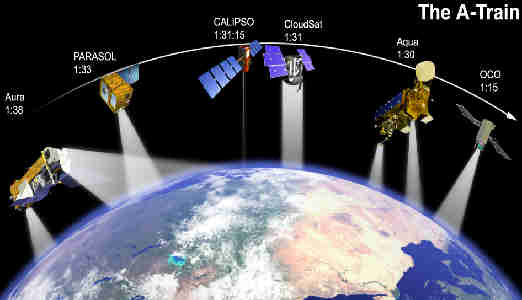
Back to the Space Place Index
Flying in
Formation
By Patrick L.
Barry
You can almost see the tabloid headlines now: "Mid-west farmer
spies UFO squadron flying in formation!" "First signs of
imminent alien invasion," the subtitle will read.
If only this fictional farmer had been keeping up with NASA's Space
Place column, he would have known better. The string of white dots
moving in formation across the pre-dawn sky were satellites, not alien
spaceships.
Beginning next year, a series of challenging, high-precision launches
will insert four satellites into orbits with just the right altitude,
position, and orbital inclination to follow in lock-step behind NASA's
Aqua satellite (launched in May 2002). Scientists have dubbed this
squadron of satellites the "A-Train." Along with Aqua, the
celestial parade will include Cloudsat, CALIPSO, PARASOL, and
Aura.
In April 2004, NASA will launch CloudSat, an Earth-observing satellite
with unique cloud-measurement abilities. These measurements will fill
an important role in our understanding of global climate change,
making long-term climate change scenarios more accurate and
dependable.
So why bother flying in formation? By passing over the same swath of
land within seconds or minutes of each other, the satellites will give
scientists snapshots of essentially the same scene using a total of 14
different measuring instruments. CloudSat alone carries only one: a
millimeter-wavelength radar sounder.
This sounder-the first of its kind put into orbit-lets scientists
see a vertical "slice" of the atmosphere that shows clouds,
water, and ice between the ground and 30 km altitude, with a vertical
resolution of 0.5 km. Even by itself, this instrument would provide an
important and unique view of Earth's atmosphere, since the accurate
portrayal of clouds is one of the glaring weaknesses with current
simulations of climate change.
But this cloud data is even more valuable when combined with
measurements from the other satellites in the A-Train-for example,
air temperature, trace gases, and radiation into and out of the
atmosphere. Scientists can then see connections between, say,
temperature and the resulting behavior of clouds. A better
understanding of these connections is one of the most sought-after
goals of climate research, because changes to global cloud cover
would, in turn, have a feedback effect on global temperatures.
The real story of this satellite squadron may not make the tabloid
headlines, but at least there's evidence that the imminent threat of
climate change is real, which is a lot more than you can say for alien
invaders!
Learn more about CloudSat and the A-Train at
cloudsat.atmos.colostate.edu . Kids (and grownups) can do
interactive cloud picture scrambles and learn "Cloudspeak" (the
names of different kinds of clouds) at The Space Place,
spaceplace.nasa.gov/cloudsat_puz.htm .
This
article was provided by the Jet Propulsion Laboratory, California
Institute of Technology, under a contract with the National
Aeronautics and Space Administration.

CloudSat, to be launched in November 2004, will take its place as
part of the "A-Train" of satellites flying in formation to
take closely timed snapshots of essentially the same scene using a
total of 14 different measuring instruments.
|
About LUNAR |
Home |
Calendar |
Contacts |
Old Gallery |
Member Pages |
Events |
Presentations & Docs |
LUNAR'clips |
Handbook |
Space Place |
Mailing Lists |
Joining |
Other Rocketry Pages |
Site Map |
Frames |
All content is the responsibility of LUNAR.
If you have comments or suggestions regarding these web pages,
please contact the 
Copyright © 1992 - 2025 LUNAR


